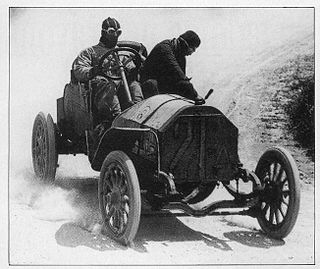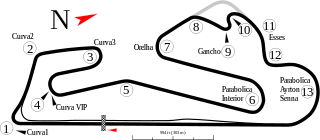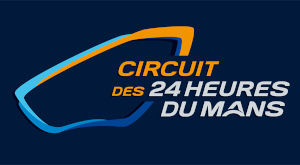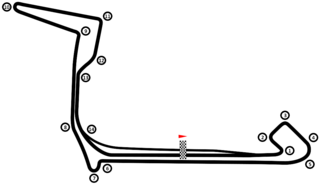This article needs additional citations for verification .(February 2024) |

The Carthage Street Circuit was a street circuit in Tunis used in the Tunis Grand Prix between 1931 and 1937.
This article needs additional citations for verification .(February 2024) |

The Carthage Street Circuit was a street circuit in Tunis used in the Tunis Grand Prix between 1931 and 1937.
The Tunis Grand Prix was originally held on a street circuit at Le Bardo, west of Tunis. After two Grands Prix, a much larger triangular highway circuit was used. [1] It was laid out between the then separate cities of Tunis and Carthage, including the one in 1933. After 1937, the Tunis Grand Prix was not held until 1955, in Parc du Belvedere as Circuito du Belvedere, which was also used during historic revival events between 2000 and 2008.
The main straight (2.25 kilometres or 1.40 miles) is now located on the N9 from Ain Zaghouan to the border with Les Berges du Lac. From there the course follows a second straight (2.32 kilometres or 1.44 miles) through El Aouina, just east of La Charguia airport. The most northern point of the course is located in La Soukra, from where it follows the N10 south down to Sidi Daoud, where a hairpin and a chicane leads back to the main straight. The total length of the circuit is 12.9 kilometres (8.0 mi).




Tunis is the capital and largest city of Tunisia. The greater metropolitan area of Tunis, often referred to as "Grand Tunis", has about 2,700,000 inhabitants. As of 2020, it is the third-largest city in the Maghreb region and the eleventh-largest in the Arab world.

The French Grand Prix, formerly known as the Grand Prix de l'ACF, is an auto race held as part of the Fédération Internationale de l'Automobile's annual Formula One World Championship. It is one of the oldest motor races in the world as well as the first "Grand Prix". It ceased, shortly after its centenary, in 2008 with 86 races having been held, due to unfavourable financial circumstances and venues. The race returned to the Formula One calendar in 2018 with Circuit Paul Ricard hosting the race, but was removed from the calendar after 2022.
Grand Prix motor racing, a form of motorsport competition, has its roots in organised automobile racing that began in France as early as 1894. It quickly evolved from simple road races from one town to the next, to endurance tests for car and driver. Innovation and the drive of competition soon saw speeds exceeding 100 miles per hour (160 km/h), but because early races took place on open roads, accidents occurred frequently, resulting in deaths both of drivers and of spectators. A common abbreviation used for Grand Prix racing is "GP" or "GP racing".

The Targa Florio was a public road endurance automobile race held in the mountains of Sicily near the island's capital of Palermo. Founded in 1906, it was the oldest sports car racing event, part of the World Sportscar Championship between 1955 and 1973. While the first races consisted of a whole tour of the island, the track length in the race's last decades was limited to the 72 km (45 mi) of the Circuito Piccolo delle Madonie, which was lapped 11 times.

The Circuit Gilles Villeneuve, also spelled Circuit Gilles-Villeneuve, is a 4.361 km (2.710 mi) motor racing circuit on Notre Dame Island in Montreal, Quebec, Canada. It is the venue for the FIA Formula One Canadian Grand Prix. It has previously hosted the FIA World Sportscar Championship, the Champ Car World Series, the NASCAR Pinty’s Series, the NASCAR Xfinity Series, and the Grand-Am Rolex Sports Car Series.

Riverside International Raceway was a motorsports race track and road course established in the Edgemont area of Riverside County, California, just east of the city limits of Riverside and 50 mi (80 km) east of Los Angeles, in 1957. In 1984, the raceway became part of the newly incorporated city of Moreno Valley. Riverside was noted for its hot, dusty environment, which was a dangerous challenge for drivers. It was also considered one of the finest tracks in the United States. The track was in operation from September 22, 1957, to July 2, 1989, with the last race, The Budweiser 400, won by Rusty Wallace, held in 1988. After that final race, a shortened version of the circuit was kept open for car clubs and special events until 1989.

The Circuito do Estoril or Autódromo do Estoril, officially known as Autódromo Fernanda Pires da Silva, is a motorsport race track on the Portuguese Riviera, outside of Lisbon, owned by state-run holding management company Parpública. Its length is 4.182 km (2.599 mi). It was the home of the Formula One Portuguese Grand Prix from 1984 to 1996. The capacity of the motorsport stadium is 45,000. The circuit has an FIA Grade 1 license.

The circuit Reims-Gueux was a motor racing circuit made up of rural public roads, located in Gueux, 8 km west of Reims in the Champagne region of north-eastern France, established in 1926 as the second venue of the Grand Prix de la Marne. The triangular layout of public roads formed three sectors between the villages of Thillois and Gueux over the La Garenne / Gueux intersection of Route nationale 31. The circuit became known to be among the fastest of the era for its two long straights allowing maximum straight-line speed, resulting in many famous slipstream battles.

The Pescara Circuit was a 16.032 mi (25.801 km) race course made up entirely of public roads near Pescara, Italy that hosted the Coppa Acerbo auto race. Pescara is the longest circuit to ever host a Formula One Grand Prix.
The Automobile Club de l'Ouest, sometimes abbreviated to ACO, is the largest automotive group in France. It was founded in 1906 by car building and racing enthusiasts, and is most famous for being the organising entity behind the annual Le Mans 24 Hours race. The ACO also lobbies on behalf of French drivers on such issues as road building and maintenance, the availability of driving schools and road safety classes, and the incorporation of technical innovations into new vehicles. It also runs a roadside assistance service for its members.

The Circuit des 24 Heures du Mans, also known as Circuit de la Sarthe located in Le Mans, Sarthe, France, is a semi-permanent motorsport race course, chiefly known as the venue for the 24 Hours of Le Mans auto race. Comprising private, race-specific sections of track in addition to public roads which remain accessible most of the year, its present configuration is 13.626 km (8.467 mi) long, making it one of the longest circuits in the world. The capacity of the race stadium, where the short Bugatti Circuit is situated, is 100,000. The Musée des 24 Heures du Mans is a motorsport museum located at the main entrance of the venue.

The Shell and Pennzoil Grand Prix of Houston Presented by the Greater Houston Honda Dealers was an annual auto race on the IndyCar Series circuit. It was held in a street circuit located in downtown Houston for four years, then returned after a four-year hiatus for two years on a course laid out in the parking lot of the Reliant/NRG Park complex. Before resuming in 2013, the last race was held on April 22, 2007,.

Tourism in Tunisia is an industry that generated around 9.4 million arrivals per year in 2016-2020, which makes it one of the most visited countries in Africa. Tunisia has been an attractive destination for tourists since the beginning of the 1960s.
The 1949 Australian Grand Prix was a motor race held at the Leyburn Airfield in Queensland, Australia on 18 September 1949. The race was staged over 35 laps of the 7.0 kilometre circuit, which was laid out on the runways and taxiways of a World War II airbase located six kilometres north of the town of Leyburn. The total race distance was 150.5 miles.

The Grand Prix of Baltimore presented by SRT was an IndyCar Series and American Le Mans Series race for 3 years held on a street circuit in Baltimore, Maryland. The inaugural race was held September 4, 2011. ESPN said it was the best inaugural street race in North America in the last 30 years. The races were contested on a temporary street circuit around the Inner Harbor area of downtown Baltimore.
The following is a timeline of the history of the city of Tunis, Tunisia.

The Tunis Grand Prix or Grand Prix de Tunis was a motor race held in the 1920s and 30s in Tunis, the capital of the African colony of the French protectorate of Tunisia.

The Lobethal Circuit was a motor racing course centred on the South Australian town of Lobethal in the Mount Lofty Ranges, 22 miles from the state capital, Adelaide. It was utilized for four race meetings from 1937 to 1948, hosting a number of major races including the 1939 Australian Grand Prix. Today the roads of the circuit make up a part of the Tour Down Under international bicycle race.

The Brooklyn Street Circuit is a street circuit in the Red Hook neighborhood of the New York City borough of Brooklyn, adjacent to the Brooklyn Cruise Terminal along Brooklyn's western coast. It was created for the New York City ePrix of the single-seater, electrically powered Formula E championship. Its first use was during the 2016–17 Formula E season when it hosted the 2017 New York City ePrix.

The Music City Grand Prix, known as the Big Machine Music City Grand Prix for sponsorship reasons, is an IndyCar Series race held at the Nashville Street Circuit in Nashville, Tennessee. The race's most notable feature is its 3,578 ft (1,091 m) straightaway across the Korean War Veterans Memorial Bridge, which spans the Cumberland River. The bridge layout makes the track the only one on the IndyCar circuit and one of the few in the world to cross a significant body of water. Marcus Ericsson won the inaugural event in 2021. The Grand Prix is set to host the season finale from 2024 onwards.
... changed the venue to the very flat triangular 12.714 km Carthage circuit, near the site of the ancient city of Carthage.